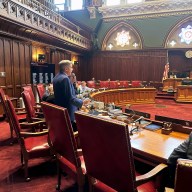 F. King Alexander is the president of California State University, Long Beach.
F. King Alexander is the president of California State University, Long Beach.
The House Budget Committee is debating freezing the maximum Pell Grant award — now set at $5,645 — for years to come, along with opening them up to future cuts. F. King Alexander is the president of California State University, Long Beach, and he believes that the government-funded Pell Grants are vital to an economically diverse student body.
Are you concerned about the status of Pell Grants for future students?
Yes. I think we lost a significant battle two years ago when Congress cut Pells for summer school. Summer classes are very important to working students and poor students. So, we’ve already had a cut in Pell. We can’t afford that at a time when tuition is rising because of state reductions.
Pell Grants cover just a fraction of the tuition at an expensive school. Why doesn’t the Pell adjust based on the cost of tuition?
That seems like a great idea on the face of it. However, if Pells were significantly higher, you’d run the risk of increasing the incentive for institutions to escalate their prices. Our campus charges $6,500 per year in tuition and fees. Community colleges hover around $3,500. The national public university average is around $8,200. So Pell does cover about two-thirds the cost for a vast majority of students.
What kinds of students get Pell Grants?
To me, the beauty of Pell is that it’s weighted on income, not price. State student-aid programs tend to be price-sensitive, which gives advantages to institutions that raise their prices. On my campus, we have 13,000 Pell students. If you give one student four times the Pell of another, you’ll deny three students access to college.
















